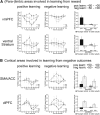Reduced striatal responses to reward prediction errors in older compared with younger adults
- PMID: 23761885
- PMCID: PMC3682384
- DOI: 10.1523/JNEUROSCI.2942-12.2013
Reduced striatal responses to reward prediction errors in older compared with younger adults
Abstract
We examined whether older adults differ from younger adults in how they learn from rewarding and aversive outcomes. Human participants were asked to either learn to choose actions that lead to monetary reward or learn to avoid actions that lead to monetary losses. To examine age differences in the neurophysiological mechanisms of learning, we applied a combination of computational modeling and fMRI. Behavioral results showed age-related impairments in learning from reward but not in learning from monetary losses. Consistent with these results, we observed age-related reductions in BOLD activity during learning from reward in the ventromedial PFC. Furthermore, the model-based fMRI analysis revealed a reduced responsivity of the ventral striatum to reward prediction errors during learning in older than younger adults. This age-related reduction in striatal sensitivity to reward prediction errors may result from a decline in phasic dopaminergic learning signals in the elderly.
Figures






References
-
- Baddeley AD, Emslie H, Nimmo-Smith I, editors. The speed and capacity of language processing (SCOLP) Test. Bury St. Edmunds, Suffolk, England: Thames Valley Test Company; 1992.
-
- Braver TS, Barch DM, Keys BA, Carter CS, Cohen JD, Kaye JA, Janowsky JS, Taylor SF, Yesavage JA, Mumenthaler MS, Jagust WJ, Reed BR. Context processing in older adults: Evidence for a theory relating cognitive control to neurobiology in healthy aging. J Exp Psychol Gen. 2001;130:746–763. doi: 10.1037/0096-3445.130.4.746. - DOI - PubMed
Publication types
MeSH terms
Substances
Grants and funding
LinkOut - more resources
Full Text Sources
Other Literature Sources
Medical
Miscellaneous
